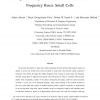Free Online Productivity Tools
i2Speak
i2Symbol
i2OCR
iTex2Img
iWeb2Print
iWeb2Shot
i2Type
iPdf2Split
iPdf2Merge
i2Bopomofo
i2Arabic
i2Style
i2Image
i2PDF
iLatex2Rtf
Sci2ools
EJASP
2011
2011
Cognitive Cooperation for the Downlink of Frequency Reuse Small Cells
We develop and analyze a space time coded cooperative diversity protocol that achieves improved quality of service for mobile users in the downlink of small cells. The protocol, called cooperative frequency reuse (CFR), leverages the cellular frequency reuse concept to create space and frequency diversity among pairs of adjacent base stations. The CFR protocol, which is consistent with the halfduplex mode assumption, consists of two phases. During the first phase, each base station transmits symbols to it own user on its dedicated frequency band, while listening to the symbols intended to the users of the other base station on another frequency band. Cognitive cooperation is implemented in the second phase. Each base station transmits on the two frequency bands to the scheduled users in both base stations, by means of an appropriately chosen space time code. We construct a full rate The work has been supported by the Agence Nationale de la Recherche within the project ANR-09-VERS0: E...
| Added | 14 May 2011 |
| Updated | 14 May 2011 |
| Type | Journal |
| Year | 2011 |
| Where | EJASP |
| Authors | Salam Akoum, Marie Zwingelstein-Colin, Robert W. Heath Jr., Mérouane Debbah |
Comments (0)

